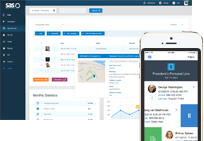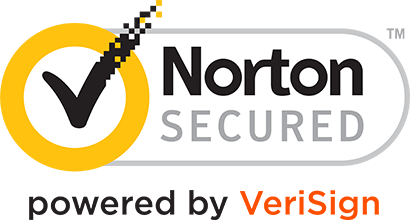- Log In
- Support
- Company
- Contact Us
- Live answers @ 1-888-532-4794
13 Tips to Answer the Phone At Your Business: A Receptionist’s Guide
Answering the phone. It’s easy, right? Maybe for a seasoned receptionist. But for someone who is new to the working world, there is a rhythm and rhyme to expert phone answering. Everyone at your business needs to know how to answer the phone professionally. Whether you’re working the front desk of a small office or answering phones at a call center, we’ve put together an infographic with the top 13 tips and tricks that will help you create a seamless reception desk.
13 Tips on How to Answer Your Business Phone Professionally
#1. Smile before you dial, and perk up when you pick up
Yes, you really can hear a smile through the phone. And callers will appreciate a receptionist with a buoyant personality. So, get to grinning!
#2. Breathe
Rushing to pick up a line will make it sound like you’re, well, rushing to pick up a line. So, pause for a quick second, and take a breath before you answer. And if you tend to take shallow breaths, it’s probably because you need to…
#3. Sit up straight
When you sit up straight, it properly aligns your abdominal muscles, diaphragm, rib cage and airway so that your body is ready to help you push out your words.
#4. Be prepared to take a message
That means 1) have your notepad handy, or open the computer’s notepad, and 2) if you’re writing, put a pen or pencil right by the phone so that you’ll have what you need right at your fingertips.
#5. Speak clearly
There’s nothing worse than a mumbler. Be sure that you enunciate when you speak so that people will understand you the first time.
#6. Speak at a reasonable volume
Don’t whisper and don’t blast someone’s ears out. This also applies to receptionists who are wearing headsets. Keep the microphone at an appropriate distance from your mouth, or the caller could wind up hearing a lot more than they bargained for.
#7. Know where the mute button is
We are only human, and there may be times when you can’t hold back a cough or a sneeze while you’re on the phone. In those cases, or if someone is making a bunch of racket in the background, it is imperative that you know where the mute button is. The last thing that you want is to “ah-choo” in the middle of a sentence or have the UPS driver drown out your conversation.
#8. Always put someone on hold if you need to confer with a colleague
In a similar fashion to the mute button, know where the hold button is. Every now and again, you’ll turn to your coworker to ask a question, and you don’t want the caller to hear your discourse. Use a simple phrase such as, “Let me see if I can find that out for you. Would you mind holding a moment?” And, always ask before you place someone on hold.
#9. Don’t chew gum
It’s simply bad form to chew gum while you’re on the phone. Not only will it get in the way of clear speech, but no one wants to be on the receiving end of chewing noises.
#10. Try not to yawn
If you’ve come in to work after pulling an all-nighter, chances are that you’ll be exhausted. Unless you’ve pumped yourself up with 3 triple-shot espressos and a case of Mountain Dew, yawning is bound to happen. So, if you can’t stop yourself from yawning, refer to #7.
#11. Don’t make background noise, such as tapping on the desk
If you’re the one making annoying background noise, putting yourself on mute isn’t going to cross your mind. Therefore, keep the fidgeting to a minimum, and give the caller the most professional experience possible.
#12. Know the answer phrase
This seems like a no-brainer. However, if you’re new to a workplace, especially one with a name that even Webster would struggle with, write out the answer phrase, include a little phonetics cheat sheet, and practice saying it out loud until it’s as easy as saying eggs and toast.
#13. Have a staff directory at your disposal
Just think of how awkward it would be for someone to ask for Mr. Kopfgeschlagen, and you’re sitting there thinking to yourself, I don’t even know how to say that name let alone figure out if he works here. That’s why you need a staff list in front of you. Be sure to highlight executives’ names, as people will likely ask for them more frequently.
Categories
- Advice (32)
- Answering Service 101 (18)
- Best Practices (10)
- Call Center Jobs (6)
- Call Center Software (20)
- Comparison (2)
- Customer Service (30)
- Funny (31)
- Holidays (19)
- Industry Hacks (19)
- Infographics (53)
- International (1)
- Medical (8)
- News (12)
- Phone Etiquette (2)
- Phones (14)
- Pricing (8)
- Quizzes (3)
- Receptionist (11)
- SAS Products (29)
- Scripting (4)
- Services (5)
- Small Business (25)
- Starting Up (7)
- Tips and Tricks (19)
- Uncategorized (1)
- Videos (19)
- Workplace (6)
Recently writen
- Call Center Script Best Practices: Advanced Script Block Tips to Optimize Your Answering Service
- January 2025 Release Notes – Adjustments to Call Details Timeline, New Scripting Updates, Live Transcription, and more!
- April 2024 Release Notes – Voicemail Greetings, Ability to Access Websites With a Username and Password, and more!
- March 2024 Release Notes – New Add-On, Settings Revamp, and more!
Follow Us
How about a demo?
We'll show you how our web portal works and answer any questions you have about SAS.
Schedule a demo








